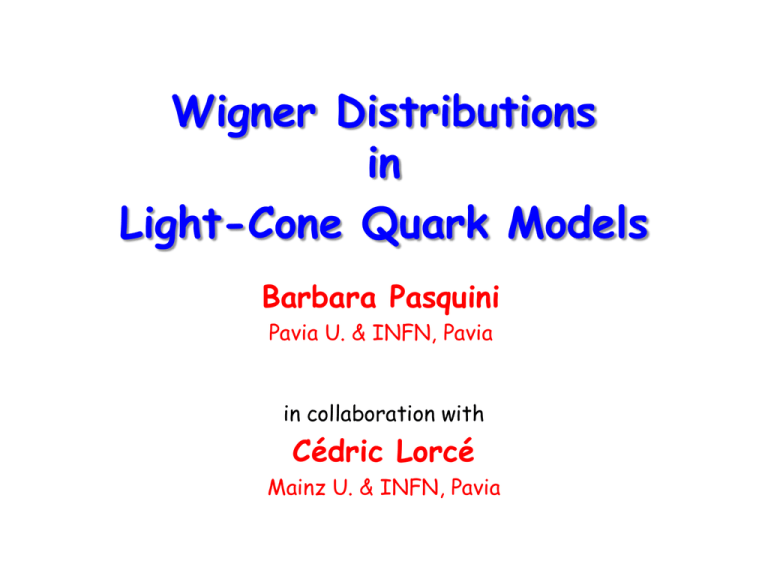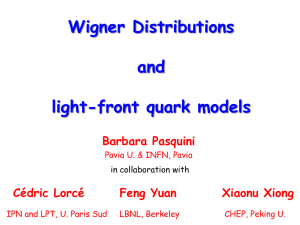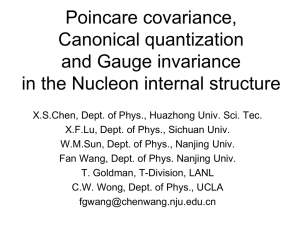Light-Cone Quark Models
advertisement

Wigner Distributions in Light-Cone Quark Models Barbara Pasquini Pavia U. & INFN, Pavia in collaboration with Cédric Lorcé Mainz U. & INFN, Pavia Outline Generalized Transverse Momentum Dependent Parton Distributions (GTMDs) FT b Wigner Distributions General formalism for the 3-quark contribution to GTMDs Results for Wigner distributions in light-cone quark models unpolarized quarks in unpolarized nucleon (generalized transverse charge density) Relations between GPDs and TMDs Relations among TMDs in various 3-quark models Orbital Angular Momentum in terms of LCWF: Ji’s vs. Jaffe-Manohar’s definition Generalized TMDs GTMDs Complete parametrization : 16 GTMDs [Meißner, Metz, Schlegel (2009)] Fourier Transform : 16 Wigner distributions [Belitsky, Ji, Yuan (2004)] x: average fraction of quark longitudinal momentum »: fraction of longitudinal momentum transfer k?: average quark transverse momentum ¢: nucleon momentum transfer GTMDs Wigner-Ds FT b FT TMDs GPDs spin densities FT PDs Form Factors charge densities Wigner Distributions Quantum phase-space distribution: most complete information on wave function quantum molecular dynamics, signal analysis, quantum info, optics, image processing,… [Wigner, (1932)] Wigner distributions in QCD: at »=0 ! diagonal in the Fock-space N N N=3 ! overlap of quark light-cone wave-functions real functions, but in general not-positive definite not probabilistic interpretation correlations of quark momentum and position in the transverse plane as function of quark and nucleon polarizations no known experiments can directly measure them ! needs phenomenological models Light-Cone Quark Models LCWF: invariant under boost, independent of P internal variables: [Brodsky, Pauli, Pinsky, ’98] momentum wf spin-flavor wf rotation from canonical spin to light-cone spin Bag Model, ÂQSM, LCQM, Quark-Diquark and Covariant Parton Models Common assumptions : No gluons Independent quarks Light-Cone Helicity and Canonical Spin LC helicity Light-Cone CQM (Melosh rotation) canonical spin rotation around an axis orthogonal to z and k? Chiral Quark-Soliton Model Bag Model Light-cone gauge A+=0 Wilson line r reduces to the identity Twist-2 operators º ! quark polarization ¹! nucleon polarization ( 16 GTMDs ) 3-Quark Overlap representation Quark line : Model Independent Spin Structure Active quark : Spectator quarks : 3-Quark Overlap representation 16 GTMDs Assumption : symmetry [C.Lorce’, B. Pasquini, M. Vanderhaeghen (in preparation)] Light-Cone Constituent Quark Model momentum-space wf [Schlumpf, Ph.D. Thesis, hep-ph/9211255] parameters fitted to anomalous magnetic moments of the nucleon : normalization constant spin-structure: free quarks (Melosh rotation) SU(6) symmetry Applications of the model to: GPDs and form factors: BP, Boffi, Traini (2003)-(2005); TMDs: BP, Cazzaniga, Boffi (2008); BP, Yuan (2010); Azimuthal asymmetries: Schweitzer, BP, Boffi, Efremov (2009) Wigner function for unpolarized quark in unpolarized nucleon T k q b k , µ fixed µ = ¼/2 T µ=0 [C.Lorce’, B. P. (in preparation)] 3/2 ¼ k k 0.1 GeV k 0.2 GeV 0.3 GeV 0.4 GeV k T ¼ T ¼/2 Unpolarized u quark in unpolarized proton T 0 , q fixed T µ T k µ = ¼/2 µ=0 Generalized Transverse Charge Densities T k = + µ=0 T k fixed Unpolarized u quark in unpolarized proton µ = ¼/2 Integrating over b ? TMD Integrating over k ? charge density in the transverse plane b? unpolarized u and d quarks in unpolarized proton neutron proton charge distribution in the transverse plane [Miller (2007); Burkardt (2007)] GTMDs TMDs GPDs GPDs and TMDs probe the same overlap of quark LCWFs in different kinematics nucleon quark at »=0 UU UT LL TU TT TT LT 0 TL 0 Relations between GPDs and TMDs in Quark Models GPDs and TMDs probe the same overlap of LCWFs in different kinematics there exist relations in particular kinematical limits? Trivial Relations UU LL TT Non-Trivial Relations TT valid also in spectator model : Meissner, Metz, Goeke, PRD76(2007) (with a factor 3 instead of 2) Model dependent relations [Burkardt, Hwang, 2003; Burkardt, 2005] SSA= GPDFSI valid for both Sivers and Boer-Mulders functions in spectator model, but breaks down at higher-orders LT 0 TL 0 GPDs at »=0 vanish because of time-reversal invariance sx up down BP, Cazzaniga, Boffi, PRD78 (2008); Lorce`, BP, in preparation Haegler, Musch, Negele, Schaefer, Europhys. Lett. 88 (2009) Light-cone quark model: ! consistent with lattice calculations Relations among TMDs in Quark Models Linear relations Quadratic relation Flavor-dependent ** * Flavor-independent ** * ** * Bag ** * [Jaffe & Ji (1991), Signal (1997), Barone & al. (2002), Avakian & al. (2008-2010)] ÂQSM [Lorcé & Pasquini (in preparation)] LCQM [Pasquini & al. (2005-2008)] S Diquark [Ma & al. (1996-2009), Jakob & al. (1997), Bacchetta & al. (2008)] AV Diquark [Ma & al. (1996-2009), Jakob & al. (1997)] [Bacchetta & al. (2008)] Cov. Parton [Efremov & al. (2009)] Quark Target [Meißner & al. (2007)] Common assumptions : No gluons Independent quarks Light-cone Helicity and Canonical Spin Quark polarization Nucleon polarization LC helicity Rotations in light-front dynamics depend on the interaction, while are kinematical in canonical quantization we study the rotational symmetries for TMDs in the basis of canonical spin rotation around an axis orthogonal to z and k? of an angle µ=µ(k) Nucleon polarization Canonical spin Quark polarization Rotational Symmetries in Canonical-Spin Basis Cilindrical symmetry around z direction nucleon spin quark spin Cilindrical symmetry around Ty k k? Spherical symmetry: invariance for any spin rotation Spherical symmetry and SU(6) spin-flavor symmetry [C. Lorce’, B.P., in preparation] Orbital Angular Momentum not unique decomposition gauge invariant, but contains interactions through the gauge covariant derivative [ X. Ji, PRL 78, (1997) ] not gauge invariant, but diagonal in the LCWFs basis [ R.L. Jaffe, NPB 337, (1990) ] Ji’s sum rule quark orbital angular momentum: What is the difference between the two definitions in a quark model without gauge fields? scalar diquark model: M. Burkardt, PRD79, 071501 (2009); LCCQM: BP, F. Yuan, in preparation Three Quark Light Cone Amplitudes classification of LCWFs in angular momentum components total quark helicity Jq J z = J z q + Lz q Lzq = -1 Lzq =0 [Ji, J.P. Ma, Yuan, 03; Burkardt, Ji, Yuan, 02] Lzq =1 parity time reversal isospin symmetry 6 independent wave function amplitudes: 0 1 2 LLzzqqq== -1 Lzq =2 Quark Orbital Angular Momentum Jaffe-Manohar and Ji OAM should coincide when A=0 ! no-gluons, only quark contribution Jaffe-Manohar definition: overlap of LCWFs with ¢Lz=0 Ji’s definition: ¢Lz=0 ¢Lz= 1 ¢Lz=0 interference between LCWFs with different Lz it is not trivial to have the same orbital angular momentum for the quark contribution Distribution in x of Orbital Angular Momentum Definition of Jaffe and Manohar: contribution from different partial waves TOT up down Lz=0 Lz=-1 Lz=-1 Lz=+2 total result, sum of up and down contributions: Jaffe-Manohar’s vs. Ji’s definition Jaffe-Manohar Ji even in a model without gauge fields the two definitions give different distributions in x Orbital Angular Momentum Definition of Jaffe and Manohar: contribution from different partial waves = 0 ¢ 0.62 + (-1) ¢ 0.14 + (+1) ¢ 0.23 + (+2) ¢ 0.018 = 0.126 Definition of Ji: [BP, F. Yuan, in preparation] [scalar diquark model: M. Burkardt, PRD79, 071501 (2009)] Summary GTMDs $ Wigner Distributions - the most complete information on partonic structure of the nucleon General Formalism for 3-quark contribution to GTMDs - applicable for large class of models: LCQMs, ÂQSM, Bag model Results for Wigner distributions in the transverse plane - anisotropic distribution in k? even for unpolarized quarks in unpolarized nucleon GPDs and TMDs probe the same overlap of 3-quark LCWF in different kinematics - give complementary information useful to reconstruct the nucleon wf Relations of TMDs in a large class of models due to rotational symmetries in the quark-spin space - useful to test them with experimental observables in the valence region Orbital Angular Momentum in terms of LCWFs: - in quark models, the total OAM (but not the distributions in x) is the same from JI and Jaffe-Manohar definitions Backup Wigner function for transversely pol. quark in longitudinally pol. nucleon b k ,µ fixed k T sx T-odd q µ = ¼/2 µ=0 T Wigner function for transversely pol. quark in longitudinally pol. nucleon Dipole T k sx fixed Monopole µ=0 µ = ¼/2 Monopole + Dipole 3/2 ¼ k k k 0.1 GeV 0.2 GeV 0.3 GeV k T ¼ T ¼/2 u quark pol. in x direction in longitudinally pol.proton T 0 , q fixed T µ T k 0.4 GeV º ! quark polarization ¹! nucleon polarization ( 16 GTMDs Active quark : Spectator quarks : Model Independent Spin Structure ) Orbital Angular Momentum in the Light-Front Light-cone Gauge A+=0 and advanced boundary condition for A generalization of the relation for the anomalous magnetic moment: [Brodsky, Drell, PRD22, 1980] complex LCWFs due to FSI/ISI [Brodsky, Gardner, PLB 643, 2006] [Brodsky, BP, Yuan, Xiao, PLB 667, 2010








